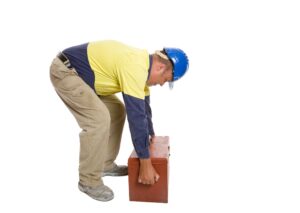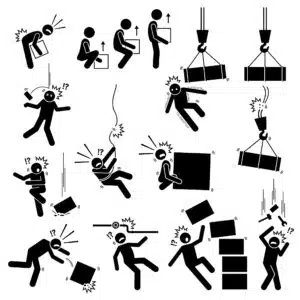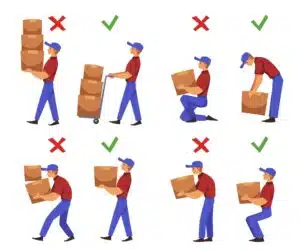In this guide, we will explore how manual handling injuries can be prevented in the workplace by examining the steps an employer must take to keep you safe at work. If you have been injured in a manual handling accident at work, you may be wondering whether you could claim compensation. We will discuss the criteria you need to meet in order to have a valid case later in our guide.
Also, this guide will provide examples of how manual handling incidents could occur in the workplace and the injuries that could be sustained as a result. We will also discuss the personal injury settlement you could be awarded to address the impact of your injuries should you make a successful claim.
Finally, this guide will discuss the advantages of using a No Win No Fee solicitor to assist you when making a manual handling claim.
If you have any questions, please don’t hesitate to get in touch. Our advisors are ready to help 24/7 and could connect you with our panel of personal injury solicitors, provided your case is valid. To speak with a member of our team you can contact us online to discuss manual handling accidents.
Choose A Section
- How Can Manual Handling Injuries Be Prevented In The Workplace?
- How To Claim For A Manual Handling Injury?
- Employer Negligence That Could Lead To A Manual Handling Claim
- Accident At Work Compensation You Could Receive
- Evidence That Could Help You Claim For Common Manual Handling Injuries
- Want To Claim For Manual Handling Injuries On A No Win No Fee Basis?
- How Can Manual Handling Injuries Be Prevented In The Workplace – Find Out More
How Manual Handling Injuries Can Be Prevented In The Workplace
Manual handling involves using bodily force to transport loads from one place to another. This can include pushing, pulling and carrying etc. If these tasks aren’t carried out safely, an injury is more likely to be sustained.
The Health and Safety Executive (HSE), Britain’s regulator for occupational health and safety, stated that 17% of all non-fatal employee accidents reported under the Reporting of Injuries, Diseases and Dangerous Occurrences Regulations 2013 RIDDOR in 2022/23 were caused by handling, carrying or lifting at work. This is by no means the full picture, as only certain accidents and injuries need to be reported to the HSE under RIDDOR.
The HSE has provided some answers to the question, “How can manual handling injuries be prevented in the workplace?”, which include:
- Make sure the person performing the task has received appropriate manual handling training.
- Always conduct assessments for manual handling risks
- For a manual handling task, try to make the load light, smaller and easier to grasp.
- Ensure the environment is safe to perform manual handling tasks.
For further information on how to prevent manual handling injuries in the workplace, see the HSE guide.
How To Claim For A Manual Handling Injury?
Employers have a duty of care to take reasonable steps to ensure the health and safety of those they employ. This duty is outlined within the Health and Safety at Work etc. Act 1974.
Providing adequate training where necessary, conducting risk assessments, and acting on the results are steps employers should take to prevent workplace injuries.
To be able to make a personal injury claim following an accident at work, the eligibility criteria below must be met:
- You were owed a duty of care by your employer.
- Your employer’s actions or inactions breached this duty of care.
- The breach of this duty of care has caused your injuries.
If you’ve experienced a breach in an employer’s duty of care that has led to your injury, you may be eligible to make a claim for compensation. Contact us today to discuss your case and to learn more about how manual handling injuries can be prevented in the workplace see the HSE website.
Employer Negligence That Could Lead To A Manual Handling Claim
The Manual Handling Operations Regulations 1992 states that each employer should avoid any hazardous manual handling operations that pose any risk of injury, so far as it is reasonably practicable. Examples of how employer negligence can lead to a manual handling claim include:
- You could be carrying a heavy object on a wet floor that doesn’t have any warning signs present. As a result, you could slip and fall and could sustain a serious injury such as a back injury.
- You’re asked to carry a large object alone. The object should be carried by two persons due to the weight. As a result, you suffer damage to the tendons and muscles in your neck as well as a herniated disc in your back.
- Due to inadequate manual handling training, you lift a heavy item from floor level without using the correct techniques. This could disturb the muscles and ligaments in your back and cause injury to your knees.
To find out if you can make a personal injury claim after suffering from a manual handling accident at work, call our advisors now for a free case assessment.
Accident At Work Compensation You Could Receive
Following a successful manual handling claim, you will receive general damages. This compensates you for the suffering you’ve experienced as a result of your injuries. When the value of general damages is being calculated, legal professionals, such as solicitors, may refer to the Judicial College Guidelines (JCG). The JCG includes compensation guideline figures for an extensive list of injuries. We have included a table that displays some of the figures listed in the 16th edition of this publication below. However, as every case is unique, these figures are only a guideline, not a guarantee.
Compensation Guidelines
Please note the first entry is not contained within the JCG.
| Injury | Details | Compensation Brackets - Guidelines |
|---|---|---|
| Multiple very serious injuries plus special damages. | Multiple very serious injuries such as spinal cord injuries and serious fractures plus their financial costs such as lost employment and at home care. | Up To £500,000+ |
| Severe Back Injury (i) | Spinal cord and nerve root damage. | £91,090 to £160,980 |
| Moderate Back Injury (ii) | Disturbance of muscles and ligaments which lead to backache. | £12,510 to £27,760 |
| Severe Arm Injury | Cases of a serious injury to the brachial plexus that leaves the claimant not much better off than if they had lost the arm completely. | £96,160 to £130,930 |
| Less Severe Arm Injury | A significant level of disability has been caused but some recovery will have taken place or will be expected to in the future. | £19,200 to £39,170 |
| Severe Neck Injury (iii) | Severe soft tissue damage or ruptured tendons causing chronic conditions and a permanent and significant disability. | £45,470 to £55,990 |
| Moderate Neck Injury (i) | Severe and immediate symptoms potentially requiring a spinal fusion from injuries such as fractures and dislocations. | £24,990 to £38,490 |
| Severe Leg Injury (iii) | Serious injuries such as compound or comminuted fractures. | £39,200 to £54,830 |
| Less Serious Leg Injury (ii) | Cases of a simple femur fracture with no harm suffered to the articular surfaces. | £9,110 to £14,080 |
Claiming For Financial Losses After A Manual Handling Injury
The secondary head of claim that you could be awarded is special damages. This may be awarded to compensate any financial losses that have resulted from your manual handling injury. These losses may include:
- Travel costs to medical appointments.
- Loss of earnings.
- Medical costs.
In order to claim these losses back, evidence in the form of receipts, payslips or invoices should be kept to strengthen your claim.
For a free valuation of your claim, you can contact our advisory team today.
Evidence That Could Help You Claim For Common Manual Handling Injuries
Obtaining evidence following a manual handling accident at work could help support you when making a personal injury claim. Collecting sufficient evidence could help with proving that your employer was liable for your injuries and how the accident occurred. Examples of useful evidence include:
- CCTV that captured the accident occurring.
- Photographs of your injuries and the site where the accident took place.
- The contact information of any witnesses that may give a statement at a later date.
- Medical records e.g. scans or X-rays.
You may require legal assistance to help your case. Contact our advisors to discuss your claim and potentially be connected with a solicitor from our panel.
Want To Claim For Manual Handling Injuries On A No Win No Fee Basis?
If you have a valid case, one of the solicitors on our panel may be able to help you with your claim on a No Win No Fee basis. By offering you a Conditional Fee Agreement, you will not have to pay for their services upfront or while the claim is in progress. If your claim fails, you won’t be required to pay your solicitor.
If your claim does win, and you are awarded a settlement, a small, legally limited percentage will be taken from the compensation. This is known as a success fee.
To find out if one of the No Win No Fee solicitors on our panel could help you with your claim, contact our advisors. To get in touch with a member of our team, you can Contact us online.
For more information about how manual handling injuries can be prevented in the workplace, see what the HSE has on its website about reducing the risk of injury.
How Can Manual Handling Injuries Be Prevented In The Workplace – Find Out More
Additional guides by us regarding personal injury claims:
Find out whether you could be eligible to make a personal injury claim for a finger injury at work and how much compensation you could be awarded if you succeed.
See if you could make a claim for slipping on a floor and how compensation is calculated
Find out if a sprained ankle at work could mean you are eligible to make an accident at work claim
Resources you may find helpful:
GOV.UK – Statutory Sick Pay
HSE – Employer’s responsibilities
GOV.UK – Request CCTV footage of yourself
Thank you for reading this guide on how can manual handling injuries be prevented in the workplace.





